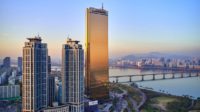Amid a backdrop of rapid societal and political changes, Saudi Arabia’s creative community of artists, architects, and designers seem poised to experience a wave of change.
Last week, the Misk Art Institute, a new organization of artists and designers backed by the Crown Prince Mohammed bin Salman’s Misk Foundation, announced its inaugural year of international programming, which will include the country’s first national pavilion at the upcoming Venice Architecture Biennale and the start of designs for a new ground-up headquarters building.
Beyond the physical spaces that Saudi designers and architects will soon inhabit, the institute’s director Ahmed Mater, an internationally acclaimed artist with a self-professed interest in documenting the country’s “unofficial histories,” is himself proof of a new generation of leadership.
At another point in the country’s history, 38-year-old Mater’s appointment may have been unlikely, but today he has received significant support from both the Saudi government and major global cultural institutions like the Museum of Modern Art, which provided the venue for Mater’s announcement in New York City.
With Mater at the helm, the Misk Art Institute—the management of which is about 60 percent women—will begin its first major building project in Riyadh this year.
For Mater, the creation of a dedicated building in the Saudi capital is a chance to propose “a new vision of what an institute of [the] 21st century will look like,” and to create a base for an organization whose reach aims to extend far beyond the country.
Mater is overseeing the design, which will be conceived by the international team of Italian architect Michele De Lucchi and his firm, aMDL, and London-based firm Skene Catling de la Peña, along with support from Factum Arte, a multi-disciplinary workshop in Madrid that uses technology to reproduce cultural heritage and hosts contemporary artists.
Though officially selected by a jury in October after participating in a design competition for the building, the team formed organically out of a series of collaborations with the Madrid-based studio.
Factum teamed up with Charlotte Skene Catling, one of the founders of Skene Catling de la Peña, to design and install the 2016 exhibition Scanning Seti: The regeneration of a Pharaonic Tomb, still on display in Basel, Switzerland. Factum has also worked with De Lucchi for about a decade at the Fondazione Giorgio Cini in Venice on various exhibitions and the conversion of a former monastery’s dorms into a library.
Factum’s founder Adam Lowe says the design team was borne out of conversations with Mater (who has created several recent works at Factum) about the goals of what the Saudi institute’s new space could be. “This collaboration of different skills seemed ideal,” he wrote in an email. “All parties committed to working on this idea and … we are delighted that our approach to the development of this artist-led initiative was selected.”
Though it’s “early days,” as Skene Catling put it, their various experiences at Factum will influence the design for the institute, which they will be developing in stages. For De Lucchi, the Madrid studio is a guide for how to incorporate the programmatic elements of the new institute, which will include gallery spaces, a theater, classroom and office spaces, and makers’ labs and studios, with new technologies that will be added into the building. “Without the experience of Factum Arte, this would be not possible,” he said.
Skene Catling, who is interested in exploring how land forms and climate could shape the ultimate form of the Misk Art Institute’s new home, notes that the building must reflect the needs of the artists who will be using the space.
“If you think of the demographics of that country being 70 percent of it under the age of 35, there’s a huge wave of energy and rethinking of how things are articulated,” she said. “We have to spend time out there with this group of people in order to define much more clearly what the brief is.”
Though no concept design is yet available, Mater himself has one design precedent he pointed to as an inspiration for the direction of the institute’s final design: Tuwaiq Palace, an undulating social club for both foreigners and locals, designed by Atelier Frei Otto in 1985. The building received the Aga Khan Award for Architecture in 1998.
Mater, who spent the better part of the last decade documenting how development has transformed the holy city of Mecca, has no interest in building a spectacle. “We don’t care about [an] iconic building,” he said at the press event last week. Rather, he hopes the new headquarters for the Misk Art Institute will seamlessly reflect its surroundings.






Post a comment to this article
Report Abusive Comment